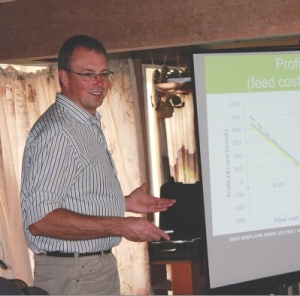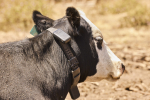University of Adelaide professor Wayne Pitchford is appearing around the country in a 14-talk Beef and Lamb organised series. Last week he was at an event on the property of Beef Producer Of The Decade Chris Biddles.
Pitchford discussed results of a four-year study which examined whether or not traditional beef stock progeny were getting ‘too soft’ and loosing other positive genetic traits as they got bigger.
Many Australian beef breeders have been selecting for larger stock with less fat mass in recent times and Pitchford says that there was a concern that these animals were becoming “European” at the expense of their ability to keep going in a drought.
When looking at EBV historical trends on the 600-day feedlot index on the Certified Australian Angus Beef scale it was found that while overall carcass weight, muscle mass and intra-muscular fat had all uniformly risen from 2000 to 2009, rump fat levels had dropped, stayed level or only increased slightly.
“Over time cattle have got bigger, more muscley and gotten leaner. While this is all well and good there is a concern that they will start crashing in tough times.”
To test this researchers took 500 cows who had yet to calve from 10 Australian studs and divided them into groups of 25 based on their fat EBV level, their nutrition intake, the level of nutrition they were on and their location.
Rib fat and back fat EBVs were used to decide which group a cow should go into. “The cows with the higher fat EBVs tended to be the smaller, earlier calving, easier doing animals.”
Researchers then followed their progress over three matings to measure their fertility and success at handling varying levels of feed.
While stock on the high nutrition diet had condition scores that rose gradually over time those on the low nutrition diet dropped dramatically after the first calving and didn’t start putting on condition till after the second calf was weaned.
Pitchford says the higher fat groups were able to remain in better condition through the duration of the experiment and at times had twice the amount of fat as those in the low fat groups. As a result they were more likely to last longer without supplementary feed when times were tight.
“Under the animal welfare charter we had to kick in supplementary feed when any animal in that group had a condition score lower than two out of a total of five. In all cases it was a genetically low fat animal that triggered supplementary feeding while the high fat cows were still OK.”
“We did a few calculations and 1mm rib fat EBV equaled ten days of extra feed that the farmer didn’t need to give them.”
More traditional cattle were also likely to be more fertile and didn’t need to reach as heavier targets for optimum results at mating.
High fat animals weighing 350 kg with 5mm of rib fat were found to be more likely to get pregnant in a nine week mating cycle than a 450kg animal with 2mm of rib fat.

















